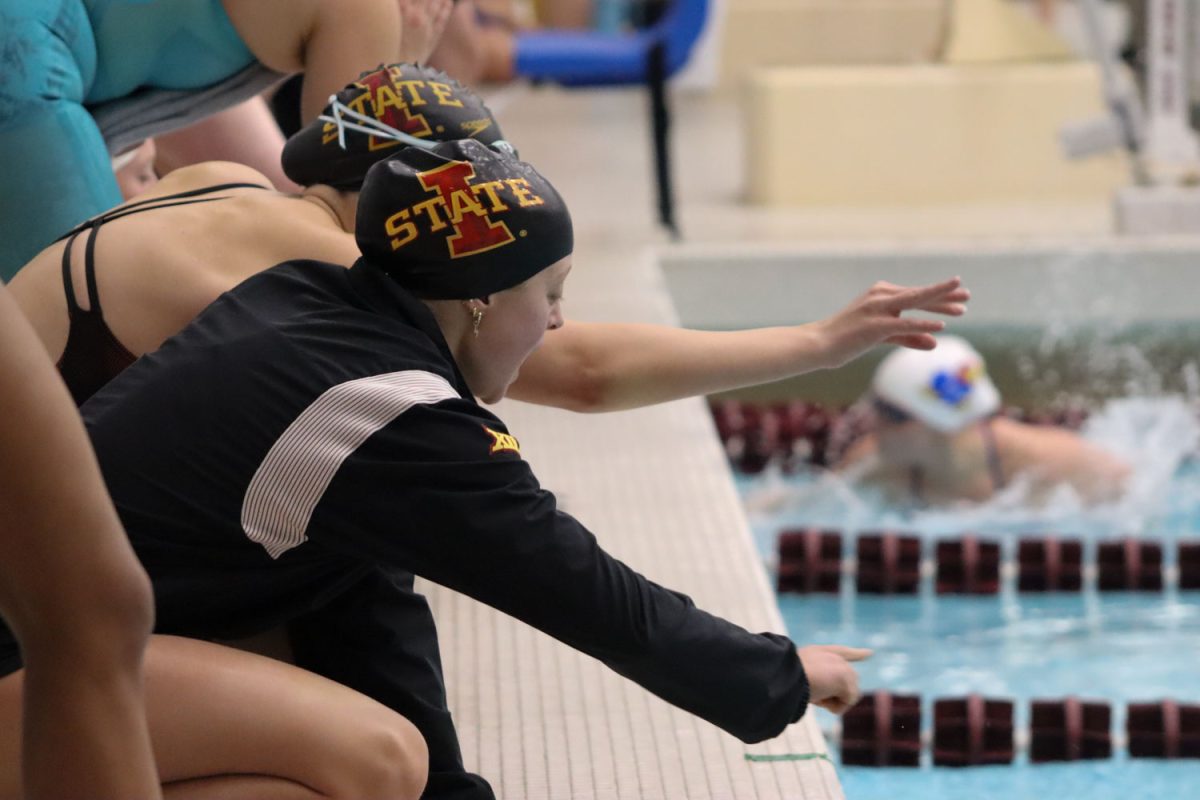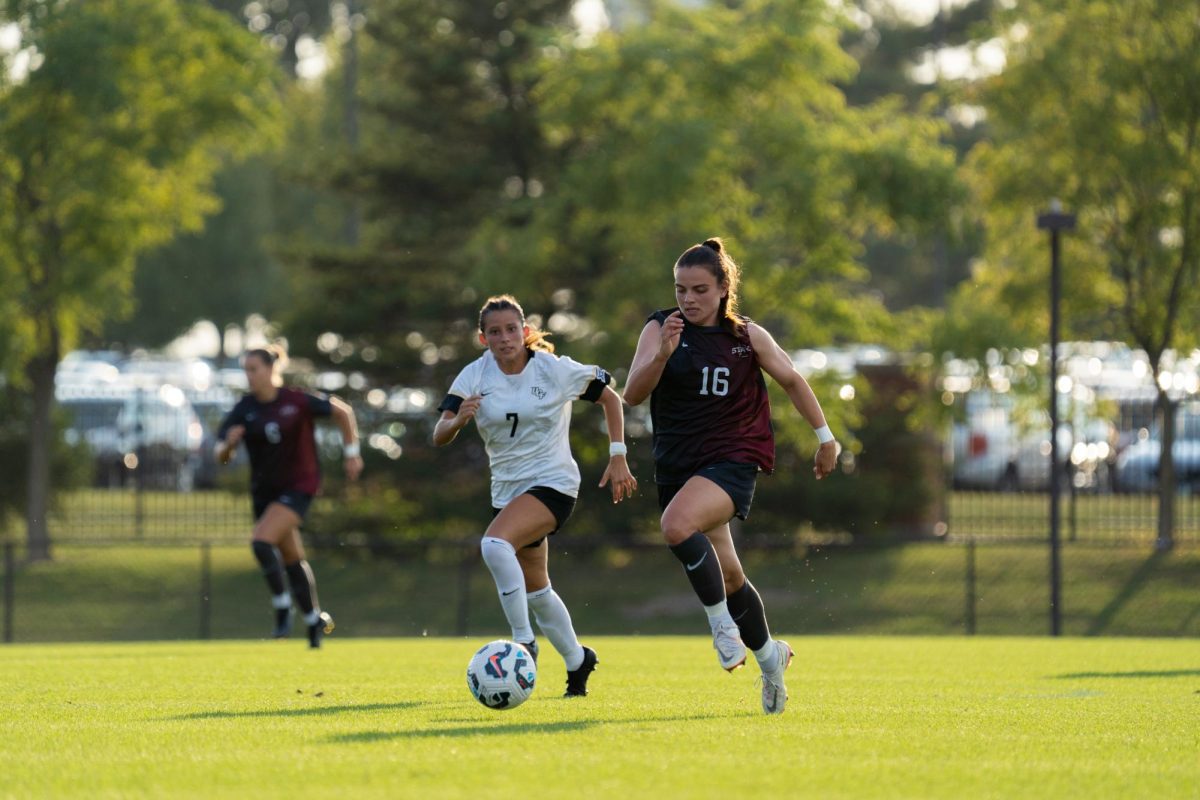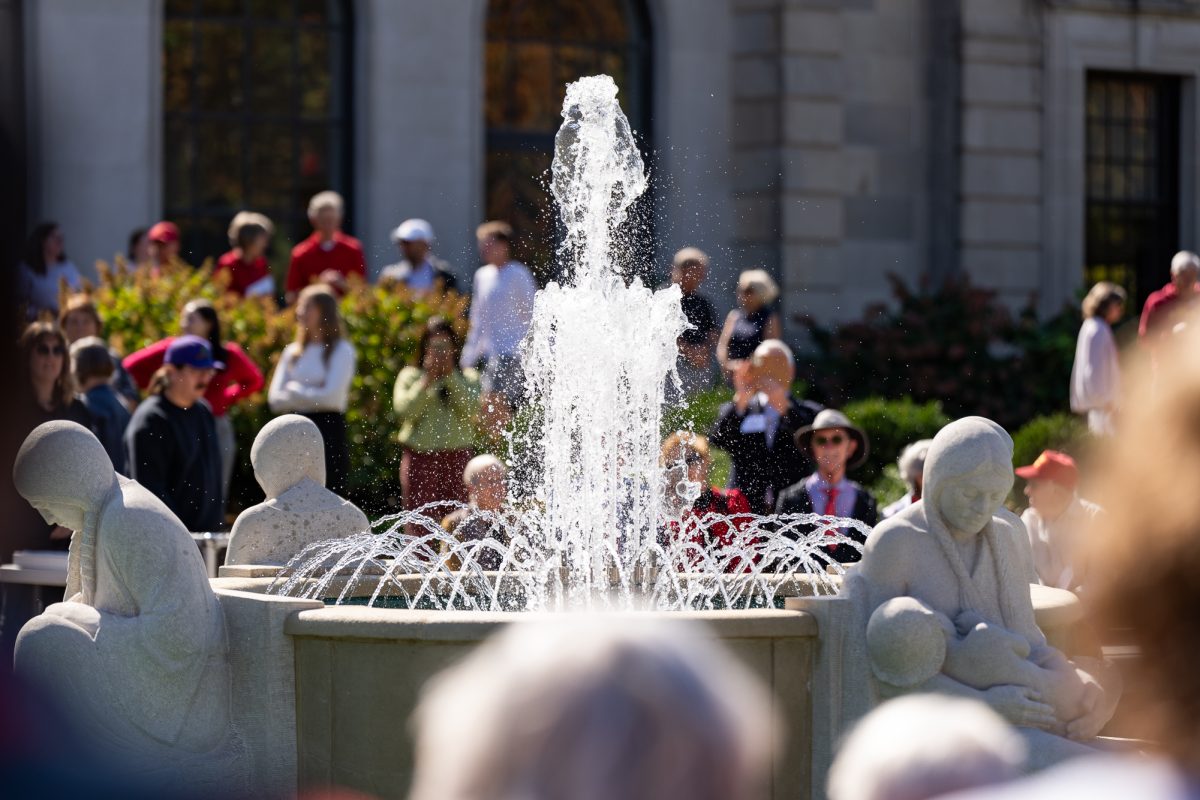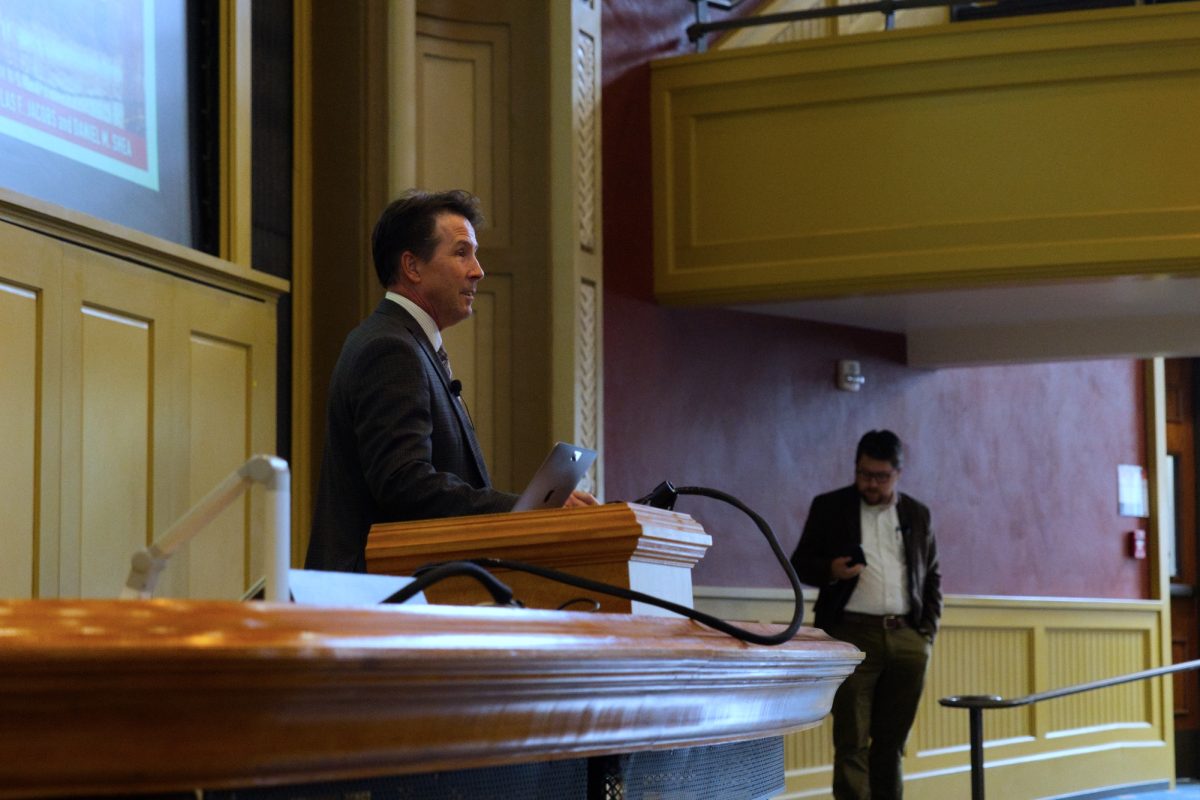Vet Med students practice pet surgery
April 30, 1999
Through the waves of aqua scrubs and powder blue or white laboratory coats, an organized chaos begins to develop amidst the hectic pace of the Small Animal Clinic of Iowa State’s College of Veterinary Medicine.
Beyond the hub of activity at the front desk, class is in session. Four veterinary medicine students, all in their final year, are reviewing their next surgical case in a small examination room at the beginning of a long hallway. Their faces, illuminated by the glow of the radiograph viewbox, are fixed in concentration as they study the degenerated hip of the surgical candidate.
The students are being quizzed on the process and the procedures of the upcoming surgery, a Femoral Head and Neck Ostectomy (FHO), by Dr. Stanley Wagner. During a FHO, the femoral head, the top of a long slim bone that meets the hip to complete the ball and socket joint, is removed to eradicate diseased bone and arthritic coxofemoral joints. A few weeks after recovering from the surgery, a dog that had the signs of hip dysplasia will be able to walk with much less pain and a slightly shorter leg after scar tissue builds around the joint, stabilizing it.
These surgical preparations have become routine for the student veterinarians as they near completion of their orthopedic surgery rotation. This is their second week with Wagner, who is head of their rotation.
By the time veterinary medicine students enter their fourth year, they already have extensive hands-on learning experiences. But the final phases of their education, the clinics, are more demanding than their previous two phases of classwork and training laboratories. According to Iowa State’s College of Veterinary Medicine home page, students are required to take 38 credits, or weeks, and this includes a 14-week required block of clinical service rotations. Students also are required to take an elective block of rotations, left to their area of interest.
Students working in their two-week training rotations must perfect their people skills as they perfect their medical or surgical experiences. Because now, the students answer to their patients’ owners as well as to their supervising professors.
Pre-surgery preparation
Wagner’s class moves down the hallway to the surgical unit. Just like undergraduates finishing recitation, the veterinary students enter their next course of the day — surgery.
As the automated doors of the operating unit slide open and shut, the faint whiff of hay and the constant ringing of the receptionists’ phones disappear. New sounds replace the calm of the pre-surgical preparation room. Here, hovering over the buzzing of an electric razor, Jennifer Thompson, a fourth-year veterinary medicine student, works diligently.
Five people, veterinary technicians, an anesthesiologist, a veterinarian and Thompson, swarm around a tall metal table, flooded with blazing lights. Almost hidden by the crowd, a 6-month-old female German Shepherd dog lies anesthetized on the table as a respiratory monitor keeps time behind her.
Clumps of fur are quickly vacuumed up after Thompson shaves the dog’s right hip joint and leg. The half-shaven dog lies quietly as the constant beeping of the pulse oximeter, monitoring her heart rate and the oxygen saturation of her blood, replaces the noisy drone of the clippers.
Continuing her pre-surgical preparation, Thompson begins the dog’s first pre-surgical scrub. Wearing a face mask and a surgical cap, Thompson starts cleaning the dog’s leg as it dangles from a string connected to an intravenous fluid stand.
This is the first of the two pre-surgical scrubs to be performed on the dog. Thompson explains that two sterile scrubs are performed in orthopedic surgery to limit bone infections.
After an extra five-minute sterile preparation, Thompson wheels the dog-laden table toward the operating room. She explains why she selected the orthopedic clinical.
“I want to have as much experience in dogs and cats as I can, so I can fall back on it,” Thompson says. Her primary interest is in equine medicine, but ISU veterinary medicine students are allowed to select much of their coursework their senior year. This allows them to tailor their education, which strengthens their areas of specialization.
Veterinary Clinical Sciences Department Chairman and Professor Christopher Brown explains that no student has the same schedule.
“There are approximately 100 students,” Brown says. So it would be plausible that there would literally be “100 different schedules.”
He says the students must spend a minimum of 38 to 39 weeks in rotation at the hospital. But the students do have the option to “embrace different areas” of medicine because of the small core of rotation requirements.
Thompson says she has enjoyed her orthopedic rotation with Wagner. And since she already has wheeled her FHO patient into the operating room for the second sterile scrub, Wagner will join her shortly.
As autoclaved, heat-sterilized tools are laid out onto a green draped table, Thompson begins the second scrub. Patiently, Thompson wipes the foaming aqua solution onto the dog’s suspended leg. Next, she sprays the cleansed area with alcohol and begins wiping in a circular pattern outward from the projected incision area.
She says this process, in theory, removes as many of the skin bacteria from the surgical site as possible. After the site is clean, she starts over.
Thompson, who has been accompanied by the anesthesiologist, is now joined by Wagner.
Working around the twisted snake-like wires of the anesthesia equipment, Thompson drapes her patient with a sterile mint-green cloth. Walking past the small monitor that steadily displays the patient’s heart rate and yellow-jagged line of electrical activity, Thompson describes what she hopes to learn in her first FHO.
Thompson says she hopes to gain improved techniques in handling the instruments and tissues. She says she also wants to improve her pre- and post-surgical care of the patient.
Thompson has had experience in surgery before her orthopedics rounds. She has already completed other clinics including neurology, ophthalmology and equine rotations, aside from the usual spays and neuters performed when she was a junior.
Wagner begins the final stages of preparing the dog for surgery. He rolls a sterile stockinette over the dog’s naked leg as the anesthesia rebreathing bag swells with each assisted breath the patient takes.
The operation
With the patient fully prepared and draped, it is now time for the first incision. Wagner, who Thompson watches closely, slices through the skin and reveals white muscle. This quickly becomes covered with blood. Thompson assists Wagner’s vision by suctioning the blood from the surgical area.
Wagner now sutures the skin to the cotton stockinette and gently divides the muscle and fat. Thompson cauterizes the blood vessels, burning the bleeders shut, before Wagner inserts retractors. The curved metal instruments just reveal the elusive white hip bone.
As Thompson continues suction, Wagner reaches for his “power tool” — a bone saw.
Over the beeping of the anesthesia equipment, Wagner and Thompson discuss the position of the surgical area. Wagner has Thompson reach her gloved hand into the incision to feel the position of the diseased joint.
Loud sucking and gurgling noises emerge from the draped area as Wagner flushes the joint. A bubbling gush of air spats up from the joint as Thompson continues suctioning the fluid.
Wagner puts his saw to use, shaving off the femoral head and neck. With the diseased ball removed from the ball and socket joint, blood now fills the suction tube instead of water.
Wagner returns with the saw to remove a little more of the diseased bone. He says it is important to remove all of the bone so the pain does not return. A small powdery cloud rises from the work area.
It is now time for the surgical team to close the incision. They work together, sewing with navy blue absorbable suture material and slowly closing the gap.
Wagner says he does not want to “make an overly large surgical exposure.” This might make recovery slower for the dog, and he says he wants to get his patient up walking quickly.
The total surgery time only lasts about 40 minutes. Thompson says this procedure is not as “technically challenging” as other orthopedic surgeries. Most orthopedic surgeries last about two hours, Thompson says.
Thompson finishes closing the incision with sutures as Wagner inspects the amputated femoral head. He says it looks as if the blood supply to the bone had been cut off, and the ball looks “dead.”
The fragment will be sent to the pathology laboratory to see if a causative agent can be found.
As far as his patient’s recovery, Wagner says the surrounding tissues will make enough scar tissue to construct a “false joint,” supporting the dog when it begins to walk.
“It should be less painful in the end,” Wagner says when comparing the post-surgical results to the patient’s pre-surgical state. He says the dog should have no arthritic changes as she ages as a result of this surgery.
Thompson and the anesthesiologist wheel the dog out of the operating room and into the radiology lab. The other fourth-year students, in their radiology rotation, will take the radiographs. After the films are developed, Wagner and Thompson will examine the radiographs to confirm enough bone has been removed.
Next, the patient is wheeled into a recovery room, where Thompson and the anesthesiologist monitor her recovery.
Post-surgery evaluation
The other orthopedic rotation students, Wendy Wentworth and Jeb Mortimer, join Thompson and Wagner in the exam room where the group first gathered. Wentworth can join her classmates because she elected to take a third week of the orthopedic rotation, instead of just the standard two-week training.
Wagner, after walking the students through the morning’s completed surgeries, starts to prepare his pupils for the afternoon’s surgical patients.
The orthopedic rotation students are not only responsible for their patients before and during surgery, they must also care for them afterward.
The three students on this rotation check on their patients when they perform “rounds” on Saturday mornings.
Wentworth and the other students examine their patients in the surgery ward, monitoring their incisions, movements, temperature and overall recovery.
After feeding and walking all of the surgical patients, the three meet back in the exam room to discuss their cases with their professors.
Wagner again quizzes his students on why and how bone damage occurs and what are the best solutions for these diseases. The students make use of a drawer full of bones to demonstrate specific cases and to target areas of concern.
Fourth-year students are not limited to ISU’s teaching hospital when completing their rotations.
Mortimer spent a few weeks at the Smithsonian Institute to gain experience in wildlife veterinary care. He said he visited another university to expand his medical training, since ISU is limited in wildlife care.
Other students train out-of-state or abroad. Wentworth says there are about five students currently studying at the University of Scotland in Glasgow.
Wentworth, who already has had three weeks of soft tissue rotation and plans on working in the equine rotation next, said ISU’s teaching hospital offers more surgical training than other universities.
Wentworth has spent some of her rotation time at the University of Tennessee, where she trained in exotic medicine. She said the university did not offer as much surgical training as ISU. There, junior students do not have the opportunity to practice surgery like they are able to at ISU, she said.
ISU, although lacking in wildlife and exotic animal medicine rotations, excels in orthopedic medicine.
The teaching hospital treats more than 12,000 small animal patients annually. Of the 1,500 small animal surgeries in the last year, 89 of these were canine hip surgeries, and 107 were major back surgeries.






